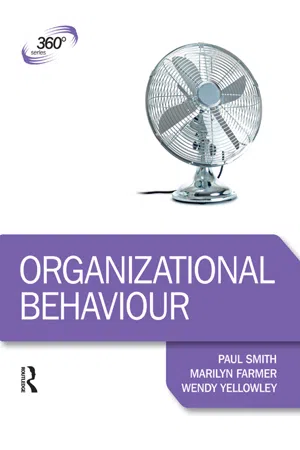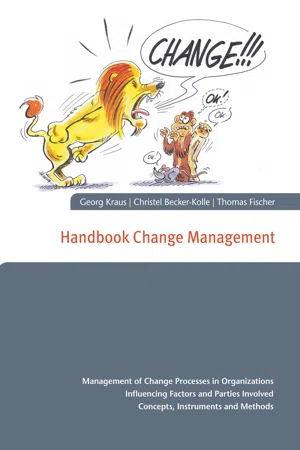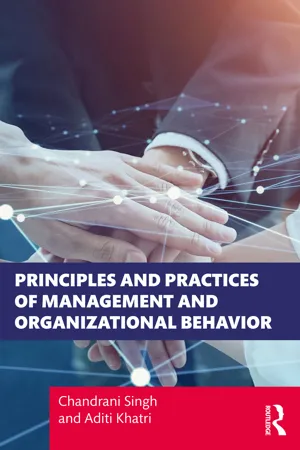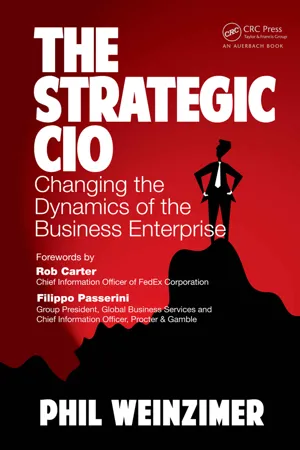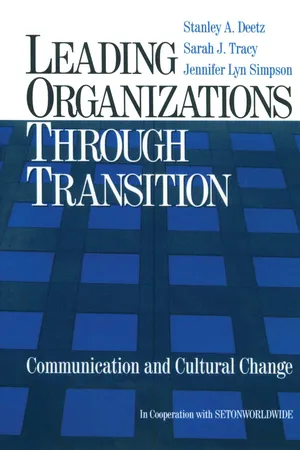Business
Understanding and Developing Organizational Culture
Understanding and developing organizational culture involves recognizing and shaping the values, beliefs, and behaviors that define a company's identity. It encompasses fostering a positive work environment, promoting shared goals, and aligning employee behaviors with the organization's mission. Cultivating a strong organizational culture can enhance employee engagement, productivity, and overall business performance.
Written by Perlego with AI-assistance
Related key terms
Related key terms
1 of 4
Related key terms
1 of 3
11 Key excerpts on "Understanding and Developing Organizational Culture"
- eBook - ePub
Multigenerational Communication in Organizations
Insights from the Workplace
- Michael G. Strawser, Stephanie A. Smith, Bridget Rubenking(Authors)
- 2021(Publication Date)
- Routledge(Publisher)
5 Perspectives on Organizational CultureThe remainder of the volume hinges on this chapter as the foundational component of the workplace. Organizational culture will be defined and presented within a historical context; then the authors will reflect on their findings and connect these findings to previous literature.5.1 Defining Organizational Culture
2020 arguably changed many personal and professional elements of the workplace. For one, suddenly, more than ever before, organizations were under attack for their values or lack thereof. As organizations learned to pivot, downsize, re-establish values, and communicate with various stakeholders, society at large was not the only group experiencing change. Organizations were under a cultural attack in many ways and were forced to reconsider all elements of the business, which collectively contribute to an organization’s culture.Organizational culture is a saturated area of study in management, business, and communication industries. Therefore, the definition of organizational culture can be complex and varied. Typically, organizational culture is defined as a set of values, beliefs, assumptions, and symbols that define the way in which a firm conducts its business (Deal & Kennedy, 1982 ). Organizational culture is important because it identifies the relevant employees, customers, suppliers, and competitors and defines how an organization will interact with these parties. Organizational culture has been correlated with competitive advantage (Barney, 1986 ), leadership (Schein, 2010 ), recruitment (Braddy, Meade, & Kroustalis, 2006 ), retention (Sheridan, 1992 ), and unethical behavior (Umphress, Bingham, & Mitchell, 2010 ), to name a few.Organizational culture helps us understand exactly how organizations accomplish goals and fulfill their missions and purposes (Sanchez, 2011 ). Culture is anecdotally referred to as “the way things are done around here,” similar to hearing “because I said so” from a parent while you were growing up. Organizational culture can seem arbitrary, but it is nonetheless pragmatic as defined by Trompenaars and Hampden-Turner (1997) - eBook - ePub
Managing Strategy
Your guide to getting it right
- Chartered Management Institute(Author)
- 2014(Publication Date)
- Profile Books(Publisher)
Understanding organisational cultureOrganisational culture is the way that things are done in an organisation, the unwritten rules that influence individual and group behaviour and attitudes. Organisational culture is defined by the organisation’s structure, the behaviour and attitudes of its employees, and the management and leadership style adopted by its managers. Organisational culture reflects the personality and character of the organisation, and is composed of the values, beliefs and basic assumptions that are shared by members of an organisation.An understanding of organisational culture is crucial for effective leadership. Leaders and managers will be better placed to implement strategy and achieve their goals if they understand the culture of their organisation. Strategies that are inconsistent with organisational culture are more likely to fail, while strategies that are in line with it are more likely to succeed. It is also important to understand the existing culture of an organisation before thinking about change.The workforce of an organisation swiftly comes to understand its particular culture. Culture is a concept that may be difficult to express plainly, but everyone knows it when they see it. For example, the culture of an informal software company may be quite different from that of a large financial corporation and different again from that of a hospital or a university.To gain an understanding of the culture of an organisation, the relationships between values, behaviour and unwritten rules must be examined. This checklist outlines the main steps and questions to ask to help gain this understanding. Some well-known methods used to classify organisational culture are also introduced.Organisations are human communities, peopled with individuals. Once managers develop an understanding of why people and their organisation behave as they do, they will be able to improve effectiveness, communication, organisation, control and, ultimately, results. - eBook - ePub
- Paul Smith, Marilyn Farmer, Wendy Yellowley(Authors)
- 2013(Publication Date)
- Routledge(Publisher)
9
Organizational culture and change
I believe that the real difference betweensuccessand failure in acorporationcan very often be traced to the question of how well the organization brings out the greattalentsof its people. What does it do to help these people find common cause with each other? And how can it sustain this common cause and sense ofdirectionthrough the many changes which take place from one generation to another? (THOMAS WATSON JR)My starting point has always been ‘change’. (ALVIN TOFFLER)CHAPTER OUTLINE1Introduction2How is organizational culture defined?3Typologies of organizational culture4Change in organizations5Change models6Changing organizational culture7SummaryBy the end of this chapter you will understand:CHAPTER OBJECTIVES• how to explain and define the meaning of the term ‘organizational culture’• the hidden and less visible aspects of culture• the different types of and varying perspectives on culture• the reasons why organizations may need to change, and the external and internal triggers driving change• the process of achieving cultural change in organizations.9.1 Introduction
KEY TERMOrganizational culture:the shared values, norms and behaviours that guide how employees work within an organization and act as a cohesive force.For many years, anthropologists have studied the norms, values and belief systems that emerge within groups of people living in the same country, region and society. These studies have demonstrated that such shared ways of behaving and thinking will also impact on the way that formal business organizations operate, and the communications and relationships of employees.One of the most well-established studies of culture was that conducted by Geert Hofstede in the 1980s. His research identified that there were common belief systems in different countries around the world. In the same way that such systems emerge within a society or country, when people come together as employees to work within an organization, over time, patterns of behaving, common attitudes and norms become established. These patterns can clearly impact on the performance of organizations and they have provided a focus for many academic research studies since the 1980s. The popular book In Search of Excellence - eBook - ePub
Handbook Change Management
Management of Change Processes in Organizations Influencing Factors and Parties Involved Concepts, Instruments and Methods
- Georg Kraus, Christel Becker-Kolle, Thomas Fischer(Authors)
- 2017(Publication Date)
- Books on Demand(Publisher)
“Even management needs external observation to mirror their own observations regarding their actions and decision making. Organizational advising offers support in reflecting that is used as a communicative arrangement for such reflection. But the communicative culture in an organization itself can open inner reflection.” (Pankoke, E.: Organization and Culture, page 31).6.4.2 Concept of a new organizational culture
The first phase in changing the culture can be developed from the analysis. Most likely, these changes have developed over the course of the employee work life. If these changes are desirable, then they can be included in the official description of desired cultural aspects.The concept and description of the new organizational culture can be:- Developed by consultants and adopted by the board,
- Developed and adopted by the board,
- Developed and adopted by the board and leadership,
- Developed by a chosen project group, which includes managers and employees, and then adopted by executives,
- Developed by consultants, the board, leadership, and employees, and adopted by the board.
Purpose: All employees should be aware of the link between the purpose of their actions and the purpose of the organization. If employees are aware of their positions within the company, they are much more likely to understand and support change.Common identity: - eBook - ePub
Giving Voice to Values-based Leadership
How to Develop Good Organizations Through Work on Values
- Gry Espedal, Frank Elter(Authors)
- 2023(Publication Date)
- Routledge(Publisher)
5 ______________________________________ DEVELOPING A VALUES-BASED ORGANIZATIONAL CULTUREDOI: 10.4324/9781003342861-5Organizational culture is the informal glue in organizations, and values are at the core of the culture that is telling people “how things are done around here.” A strong culture can provide consistency and direction, guide decisions and actions, fuel the workforce, and help organizations to reach their potential. But for any organization, change is inevitable. Changing customer demands, new technology, changed governmental regulations, geopolitical tensions, and crises are all examples of driving forces requiring change. In the private sector, companies carry out major transformations to digitalize production processes and customer interaction and to arrange for sustainable operations and products. When organizations are undergoing mergers and acquisitions, two cultures need to be aligned to succeed.The public sector is also undergoing fundamental reforms and changes. In Norway, the spread of new public management was one transformation driver of the hospital sector. The police have undergone fundamental reforms in services, locations, and organizations. The EU reported in its eGovernment Benchmark that governmental agencies across Europe are carrying out turnarounds to become better digital service organizations for their citizens (EU, 2022). These examples illustrate that major transformations take place in both the private and public sectors. When what an organization does and how it is done are undergoing fundamental change, the culture may need to evolve accordingly.There is not yet a consensus on what organizational culture is, and many definitions are available. We subscribe to Schein’s definition of organizational culture: - eBook - ePub
Cybersecurity ABCs
Delivering awareness, behaviours and culture change
- Jessica Barker, Adrian Davis, Bruce Hallas, Ciarán Mc Mahon(Authors)
- 2021(Publication Date)
- BCS, The Chartered Institute for IT(Publisher)
It is not uncommon, and arguably reasonable, to say that culture is intangible. This may explain why culture is often seen as an abstract concept. Its abstract nature is what, to many, makes the challenge of understanding, influencing and then measuring culture so difficult to overcome. Definitions of (organisational) culture include the following: 55 The accumulation of individuals’ behaviours, goals and values. How employees think and act when management is not in the room. Culture is how things actually get done around here. Customs and rituals developed by a group over time. The norms and practices that organisations develop. The culture of a group is: … a pattern of basic assumptions invented, discovered or developed by a given group as it learns to cope with its problems of external adaptation and internal integration that has worked well enough to be considered valid, and therefore, to be taught to new members as the correct way to perceive, think, and feel in relation to those problems. (Schein, 1985, 2016) Culture is the social ‘programming of the mind that distinguishes the members of one category of people from another’ (Hofstede et al., 2010). Culture is behaviour and behaviour is culture (Hammerich and Lewis, 2013). Even as we struggle to correctly define organisational culture, we have to contend with other factors that can influence and alter our perception and definitions of culture - Chandrani Singh, Aditi Khatri(Authors)
- 2024(Publication Date)
- Routledge India(Publisher)
An organization with a strong culture enables employees to get a chance to set the performance standards. They try to achieve the standards. It becomes a tool depending on which organizations develop and prosper.16.22.5 Culture within Organizations Mentors Employees
Organizational culture acts as a motivator that forms a base for employee guidance and control.16.22.6 Organizational Culture Also Helps in Attainment of Goals
A robust culture directs the stance and conduct of the employees toward the accomplishment of goals.16.22.7 Culture Orients People toward Development
Organizational culture develops implicit rules which orient people toward self-development and discipline.16.22.8 Culture Inculcates Positive Attitude
Culture inculcates a positive attitude and good behavioral norms among employees.16.22.9 Conflict Reduction
A common culture promotes steadiness in observation and reduction in conflict because every employee is aligned to the culture of the organization.16.22.10 Coordination and Control
Organizational culture promotes steadiness of viewpoint and facilitates processes of coordination and control.16.22.11 Uncertainty Reduction
Adopting the cultural mind-set simplifies the work methods and helps in selecting alternatives easily and initiating actions in response to the alternatives.16.22.12 Motivation
A consistent and unified culture motivates employees to develop their identity, foster belief and loyalty, and perform to their potential.16.22.13 Competitive Advantage
Strong culture improves the organization’s chances of being successful in the market.16.23 Types of Organizational Culture
16.23.1 Normative Culture
In such an organizational culture, the standards and procedures are defined before, and the rules and regulations are set accordingly. The employees are bound by norms and stick to the policies, and there is no attempt to break the rules. For example, Accenture has a normative organizational culture where standards and procedures are already set.- eBook - ePub
The Strategic CIO
Changing the Dynamics of the Business Enterprise
- Philip Weinzimer(Author)
- 2018(Publication Date)
- Auerbach Publications(Publisher)
Organizational culture is composed of underlying characteristics that can complement and/or compete with the characteristics of other types of organizational cultures within a company. Organizational culture is the outcome of group behavior and norms, which represent the rules that govern the group behavior. Personnel turn off cell phones in meetings as a sign of courtesy to fellow attendees, respect the opinions of others during group discussions, and encourage open communication. These are all behaviors that groups of people accept as rules that govern the work environment. Sometimes, group norms can be in conflict. Encouraging creativity and innovative work habits may be acceptable in the advertising department but conflicts with the activities of the medical laboratory environment that processes blood samples. Each of these group norms is acceptable behavior, but not conducive to the specific work environment.4. Organizational culture must be measured—both current and desired state.Measuring your organization current versus desired state is important because it will identify any potential gaps that can impede your organization’s ability to perform work effectively. For example, you need to identify some alternative scenarios for developing an application enhancement for the sales organization. You ask a group of developers to meet and discuss the requirements with a group from the sales organization. Together, they together, identify a few scenarios based on risk, cost, and schedule. If the underlying behavior characteristics in your development team include a work environment that is isolated from the business and is a very structured and controlled environment, then it would be difficult for the developers to work in a collaborative environment with business teams. If you do not measure the current state as well as the desired state of your organizational culture, you will never know what roadblocks are ahead of you when implementing new strategies.These are the four concepts that we will analyze in this chapter. Understanding these four concepts will help you determine the appropriate strategic IT competencies and skills your IT teams and other business unit teams require to be successful in implementing your company business model, the topic of the next chapter. - eBook - ePub
Introduction to the Principalship
Theory to Practice
- Leslie S. Kaplan, William A. Owings(Authors)
- 2023(Publication Date)
- Routledge(Publisher)
7- Accumulated shared learning. An organization's culture results from shared learning. The group's identity forms and coheres around this shared learning, stabilizing, and defining the group's purpose (mission) or “reason to be” that gives meaning to their daily activities and work. If these beliefs, values, and behavioral norms help the organization succeed, members will teach them to newcomers.
- Basic taken-for-granted assumptions – The cultural DNA. The group's earliest shared learning provides meaning and stability and becomes their “cultural DNA” – the non-negotiable, taken-for-granted basic assumptions, beliefs, values, and desired behaviors that started the group and made it successful and eventually drop out of awareness. These factors cannot be changed without also changing the group fundamentally. Culture-change (i.e., school improvement) programs only work if they are consistent with the group's cultural DNA.
- Solving problems of external and internal adaptation. Leaders and members develop two types of leadership needed for long-term group performance: a “task” leader and a “social-emotional” leader who shows individual consideration to members. Different people within the group typically take on these roles.
- Solutions that have worked well enough to be considered valid. Groups are created for a purpose. They act and get feedback on whether they are accomplishing their purpose. If the group continues to succeed, the beliefs, values, and behavior patterns that the group started become accepted as the right way to continue. Consenting to these assumptions and behaviors become the price of group membership.
- Perception, thought, feeling, and behavior. With success and further shared experiences, group members develop common ways of thinking and perceiving their environment. The group often develops its own language, “jargon,” often expressed as shorthand and acronyms, humor, and terms that symbolize the “essence” of their shared experience. For example, Apple's former motto, “Think different” told employees to contribute by reasoning innovatively “outside the box” and feel free to express themselves personally in their own style.8
- eBook - ePub
Leading Organizations through Transition
Communication and Cultural Change
- Stanley A. Deetz, Sarah J. Tracy, Jennifer Lyn Simpson(Authors)
- 1999(Publication Date)
- SAGE Publications, Inc(Publisher)
2Assessing and Changing Organizational Culture
OverviewAlthough most cultures are fairly deeply held and resistant to change, with careful attention cultures can and do change. This change can take many forms. A culture can be accentuated and its strength increased, it may be incrementally changed over rather lengthy periods of time, or it may be radically transformed usually over shorter periods of time. Each of these types of changes requires progressively more focused attention by organizational leaders or significant environmental changes—and often both—for transformational changes to occur.Like any change in business strategy, cultural change can, and should, only be attempted with a clear plan and clear objectives. Before initiating a change process the organizational leader should be clear as to what the character of the existing culture is and what functions the existing culture performs. This requires careful assessment. - eBook - ePub
The Complete Guide to Knowledge Management
A Strategic Plan to Leverage Your Company's Intellectual Capital
- Edna Pasher, Tuvya Ronen(Authors)
- 2011(Publication Date)
- Wiley(Publisher)
Tuvya was overwhelmed by the intensity and similarity of the message. Again and again these experts emphasized the same basic ideas: that you need to find common, shared, and positive group values among your colleagues; treat people well and empower them; and refrain from intimidation tactics. While these KM experts might have a common (and more liberal) background, the same message was given by various other people, all expected to present a capitalist or “strictly business” viewpoint:- When Tuvya met a venture capitalist, he opened by saying, “Well, before we begin talking about knowledge management, I must tell you that the most important thing is having the right organizational culture …” (You can guess the rest.)
- Another “strictly business” example is from Pat Sullivan’s book Value Driven Intellectual Capital .1 This book is decidedly about economics and extracting dollar value from intellectual capital. Sullivan nevertheless dedicates a full chapter to the same message, describing the “right culture” and emphasizing its importance.
While Tuvya believed culture was important to an organization, he also thought it was self-evident. He assumed that everyone working with—or in—knowledge organizations would see it as obvious enough to not even mention it in too much detail. So why did participants feel the need to push this point over and over? We think there is a strong message here, which should not be considered obvious or trivial, about the need for the right culture and values, and we dedicate this chapter to that message.The Definition of CultureCulture is composed of three building blocks: beliefs, values, and behavioral norms. Values hold a central position in organizational culture. They reflect the person’s or the organization’s sets of beliefs and assumptions about the external and internal environment. They also serve as the basis of the norms that underlie behavior. These norms, and many of the behaviors associated with them, reflect the organization’s values. This is why it is so important to address values in managing knowledge—they relate to both norms and beliefs. They reflect backward, since changing values can change beliefs, and forward, by affecting norms of behavior.
Index pages curate the most relevant extracts from our library of academic textbooks. They’ve been created using an in-house natural language model (NLM), each adding context and meaning to key research topics.
Explore more topic indexes
Explore more topic indexes
1 of 6
Explore more topic indexes
1 of 4


